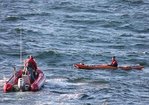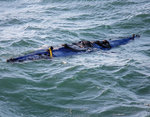An outdoor adventurer from Germany was in the wrong place with the wrong type of kayak Aug. 4 when locals came to his rescue.
Nick Scoville, lead guide for the Kayak Center at PT Outdoors, is …
This item is available in full to subscribers.
We have recently launched a new and improved website. To continue reading, you will need to either log into your subscriber account, or purchase a new subscription.
If you had an active account on our previous website, then you have an account here. Simply reset your password to regain access to your account.
If you did not have an account on our previous website, but are a current print subscriber, click here to set up your website account.
Otherwise, click here to view your options for subscribing.
* Having trouble? Call our circulation department at 360-385-2900, or email our support.
Please log in to continue |
|


An outdoor adventurer from Germany was in the wrong place with the wrong type of kayak Aug. 4 when locals came to his rescue.
Nick Scoville, lead guide for the Kayak Center at PT Outdoors, is being praised for towing a 9-year-old boy's kayak safely to shore and returning to wind-whipped waves off Point Wilson to help a 57-year-old male kayaker.
The tourist's boat swamped and he spent about 25 minutes in 54-degree water but without Scoville's presence, things could have turned deadly.
“Nick is amazing. He is a real good paddler,” PT Outdoors owner Walt Washington said of his 26-year-old employee who has only been here since May. “He took a big risk going out there twice.”
Marine Assist of Port Hadlock, East Jefferson Fire Rescue and the crew of the ferry MV Chetzemoka were also integral to the rescue effort. Here is how the incident unfolded:
Three tourists from Germany – Annette Bauer, Reinhold Strecker and Sergei Strecker, age 9 – launched their kayaks from the downtown waterfront at about 3 p.m. Aug. 4. The boy was in a sea kayak rented from PT Outdoors but the adults were using lightweight, collapsible kayaks they had brought from Germany. This is their first visit to the Pacific Northwest, but they have taken their folding kayaks to Norway, Canada and Russia – and have a travelogue website to prove it.
Scoville was escorting a 10-person kayak tour to the beach at Fort Worden State Park. Being a kayak guide means staying alert, and he had been watching these three other kayakers for about an hour. About 6 p.m., with his tour landing, Scoville noticed that one of the other three kayakers (the woman) had reached shore, but the other two were about three-quarters of a mile offshore Point Wilson.
The wind was blowing about 15 knots offshore when Scoville paddled out to help. About a mile offshore, he found the boy in one kayak and an adult man in the other. The boy was having difficulty, so Scoville linked his tow harness to the boy's kayak.
“I informed the older paddler that I was going to help him and that he needed to listen to my instructions and follow me back to shore,” Scoville said. But when Scoville headed southwest out of the wind and current, the man turned more northwest, directly toward Point Wilson.
Scoville towed the boy and his kayak to the beach, dropping him off to his mother at about 6:30 p.m. – and went back out for the man.
Meanwhile, Walt Washington had closed his shop and went to Fort Worden to help retrieve the tour group. He had noticed the stray kayakers and went to look with his binoculars, and that is when he spotted Scoville coming to the beach with the boy in tow.
“[Scoville] unhooks, gives me the OK sign and heads back out, before I can get down to the beach,” said Washington, who then recognized the woman and boy as having been at the kayak rental shop earlier in the day.
Washington tended to the tour group then looked again through binoculars to see Scoville paddling toward the kayaker, who had lost ground against the wind and was now 1.5 miles offshore and in the Admiralty Inlet shipping lanes. At 6:44 p.m., Washington called 911, with his call routed to the U.S. Coast Guard. The Coast Guard only responds to distress calls when a life is in danger, which Washington said was not the case just yet, but soon could be. Washington said the petty officer took his cell phone number and said he would call back.
Washington called 911 at 6:54 p.m. to report that the wind was picking up and the two kayakers were “disappearing behind ever increasing waves.” JeffCom 911 Communications routed him again to the Coast Guard, which put out a mariner's radio alert. Otherwise, a Coast Guard boat was 45 minutes away. “I tell them that will be too late.”
Scoville, meanwhile, had reached the man and taken his boat under tow. But with waves at three to four feet, in about 15 minutes the man's kayak swamped. Scoville said he unhooked his tow, drained water from the man's boat, which contained camping gear, and attempted to get him into it – to no avail because the boat swamped again. The collapsible boat does not have bulkheads so once water got in the main compartment, it was over.
"I knew Walt had called [911] so I put him [the kayaker] on the nose of my boat and called 911," Scoville said of his call at 6:56 p.m.
At 6:57 p.m., JeffCom toned East Jefferson Fire Rescue. Firefighters and paramedics responded by vehicle to the Fort Worden beach but the fire district’s rescue boat is in the shop for pump repairs, and has been all summer. East Jefferson's on-duty lieutenant asked JeffCom at 6:59 p.m. to summon Marine Assist of Port Hadlock.
About 10 minutes after the kayaker entered the water, a passing sailboat came to offer assistance, but its crew could not control the boat effectively or safely in the wind.
Capt. Roger Slade of Marine Assist of Port Hadlock praises the working relationship his business has with East Jefferson Fire Rescue, JeffCom and the Coast Guard. Although his company is contracted to help disabled boats – he receives no compensation for helping a kayaker; his crews respond as needed, 24/7. Boaters take note of the vessel assist number: 360-301-9764.
Slade dispatched Capt. Christian Riker to take a boat from the marina in Port Hadlock, about 20 minutes from Point Wilson. But crewmember Erik Wennstrom "used his head" and because he was already in Port Townsend, he responded with the company's 16-foot rigid inflatable from the Boat Haven – about 10 minutes from the accident scene.
The MV Chetzemoka also rerouted to provide assistance, and Scoville said the crew had the ferry's small boat in the crane ready to lower when a rigid inflatable from Marine Assist appeared.
Scoville said the swimmer had been in the water about 25 minutes when Wennstrom pulled his rigid inflatable alongside the kayak and scooped Reinhold Strecker aboard. After rushing the man to waiting paramedics on the beach, Wennstrom returned to make sure Scoville made it back on his own.
Strecker had been in the water for about 25 minutes. He was transported to Jefferson Healthcare for treatment of hypothermia.
"If he had not had a life jacket on, he would not have made it," Capt. Slade said of the kayaker/swimmer. "He had no strength left. The first stage of hypothermia is you lose strength in your extremities."
The incident is a reminder of how quickly anyone in a small boat or kayak can get into trouble with the fast currents around Admiralty Inlet.
Scoville has taken plenty of kayak rescue classes, but this is the first time he made a mayday response.
“Anytime this happens it is a combination of mistakes that add up,” Scoville said, including improper gear and lack of awareness to weather and a paddler's own ability.
Washington followed up with the German family and invited them to a free kayak safety training session Aug. 7 at the Port Townsend pool; he conducts them monthly.
The family appreciated the offer, and decided to take rented kayaks onto Port Townsend Bay, Aug. 8.
“If we had an accident it would be best to repeat so that you don’t get fear,” Annette Bauer said of why the family took to the water Monday. They appreciated the care and support shown by everyone here in Port Townsend.
What lesson did Reinhold Strecker learn on this adventure?
"Be careful."